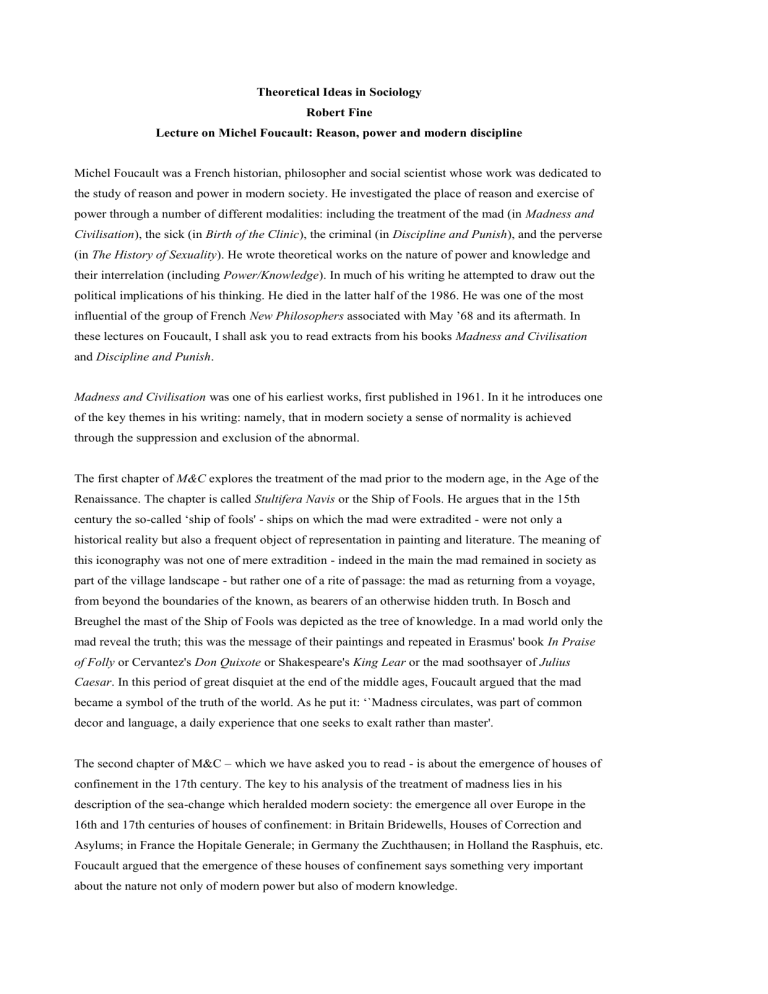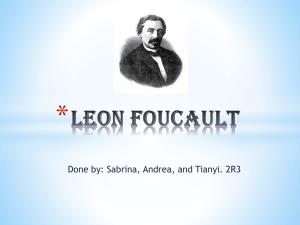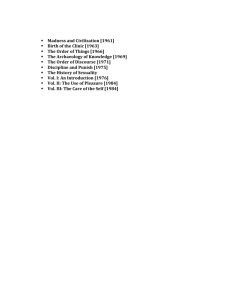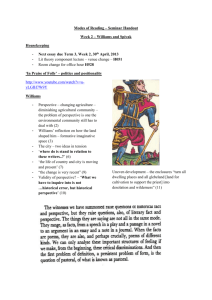Michel Foucault: Reason and the Suppression of Unreason

Theoretical Ideas in Sociology
Robert Fine
Lecture on Michel Foucault: Reason, power and modern discipline
Michel Foucault was a French historian, philosopher and social scientist whose work was dedicated to the study of reason and power in modern society. He investigated the place of reason and exercise of power through a number of different modalities: including the treatment of the mad (in Madness and
Civilisation ), the sick (in Birth of the Clinic ), the criminal (in Discipline and Punish ), and the perverse
(in The History of Sexuality ). He wrote theoretical works on the nature of power and knowledge and their interrelation (including Power/Knowledge ). In much of his writing he attempted to draw out the political implications of his thinking. He died in the latter half of the 1986. He was one of the most influential of the group of French New Philosophers associated with May ’68 and its aftermath. In these lectures on Foucault, I shall ask you to read extracts from his books Madness and Civilisation and Discipline and Punish .
Madness and Civilisation was one of his earliest works, first published in 1961. In it he introduces one of the key themes in his writing: namely, that in modern society a sense of normality is achieved through the suppression and exclusion of the abnormal.
The first chapter of M&C explores the treatment of the mad prior to the modern age, in the Age of the
Renaissance. The chapter is called Stultifera Navis or the Ship of Fools. He argues that in the 15th century the so-called ‘ship of fools' - ships on which the mad were extradited - were not only a historical reality but also a frequent object of representation in painting and literature. The meaning of this iconography was not one of mere extradition - indeed in the main the mad remained in society as part of the village landscape - but rather one of a rite of passage: the mad as returning from a voyage, from beyond the boundaries of the known, as bearers of an otherwise hidden truth. In Bosch and
Breughel the mast of the Ship of Fools was depicted as the tree of knowledge. In a mad world only the mad reveal the truth; this was the message of their paintings and repeated in Erasmus' book In Praise of Folly or Cervantez's Don Quixote or Shakespeare's King Lear or the mad soothsayer of Julius
Caesar . In this period of great disquiet at the end of the middle ages, Foucault argued that the mad became a symbol of the truth of the world. As he put it: ‘`Madness circulates, was part of common decor and language, a daily experience that one seeks to exalt rather than master'.
The second chapter of M&C – which we have asked you to read - is about the emergence of houses of confinement in the 17th century. The key to his analysis of the treatment of madness lies in his description of the sea-change which heralded modern society: the emergence all over Europe in the
16th and 17th centuries of houses of confinement: in Britain Bridewells, Houses of Correction and
Asylums; in France the Hopitale Generale; in Germany the Zuchthausen; in Holland the Rasphuis, etc.
Foucault argued that the emergence of these houses of confinement says something very important about the nature not only of modern power but also of modern knowledge.
It is reckoned that one out of every 100 persons in France was placed in a Hopitale Generale . It had little to do with medical hospitals as we know them. It was an institution that was responsible for the poor of the city. Into this institution of confinement was congregated what is to modern eyes a scandalous medley of different types of persons: paupers, prostitutes, orphans, invalids, the old, beggars, the mad, the criminal, defrocked priests, sexually sinful women, etc. The question Foucault posed was what sensibility united these apparently distinct categories in the classical age. His answer was that the institution was centred on the condemnation of idleness and the imperative of labour and that it expressed the emerging normative order of modern society.
These institutions never functioned very well as places of forced labour - though in Britain galley slavery and deportation did to some extent - but in them the ethic of work was enforced as a fundamental moral principle. Most of the labour performed in these burgeoning institutions was of little or no economic value. The real meaning of these institutions, Foucault argued, was to provide an
‘ethical consciousness of labour'. Idleness was a sin and labour its punishment. The idle poor were seen to suffer from a `weakening of discipline and the relaxation of morals'. An array of immoralities was associated with them: ‘many among them of either sex live together without marriage, many of their children are unbaptised... almost all of them live in ignorance of religion...'.
Institutions of confinement were marked by their extreme cruelty. Inmates were treated very much like animals. Among the inmates a particular cruelty was reserved for the mad. They were not only animalised but often exposed to public gaze. The mad were put on show; sometimes in the form of a theatrical drama (Marat Sade). Foucault's analysis of the particular place of the mad is ingenious. To be idle, not to work, is to violate the emerging bourgeois ethic. But according to this same bourgeois ethic, adherence to this norm of work is the very essence of what it is to be a rational human being.
Idleness was not seen merely as an offence against the bourgeois normative order but as a violation of reason – a loss of humanity.
The institutions of confinement functioned to display the truth of those who violated the bourgeois norm of work: they were not human, they lacked reason, they were like animals. Now Foucault began to understand the strange ritual of displaying the mad, for example, of people paying to watch the insane at Bethlem, for they personified the association between idleness, unreason and animality.
What was made clear to all through this display of the mad - caged, chained, covered in straw and excrement - was precisely their inhumanity. The spectacle of madness revealed that unreason was controlled, imprisoned, contained. It was something to look at but not to mingle with. It was no longer present everywhere as it had been in the Renaissance, mingling with every day experience through the images it awoke or the dangers it posed. Rather, it became an object to be stared at, with no intrinsic relation to the eye of reason that was looking at it except as a spectacle of what lies on the other side of reason if we let down our guard. As Foucault put it,
The animal in man no longer has any value as the sign of a beyond; it has become madness without relation to anything but itself.
A famed keeper of the insane in Scotland was a farmer named Gregory, renowned for his excellent treatment of the mad. According to the 18th century reformer, Pinel,
His method consisted in forcing the insane to perform the most difficult tasks of farming, in using them as beasts of burden, as servants, in reducing them to an ultimate obedience with a barrage of blows at the least act of revolt.
Such animalisation of the confined was as it were the dark side of the Age of Reason and of the new humanism it expressed. The Hȏpitale Generale was evidence of the unreason of all who were outside the bourgeois order. No longer could the mad be seen as roaming witnesses of truth, but only as visible symbols of unreason.
What was introduced in the 17th century, in Foucault's analysis, was a new set of norms around the imperative of labour that Weber analysed in his Protestant Ethic . This represented a change both in the content of the moral order (from one in which poverty was seen as a blessing and charity as a duty to one in which poverty was a sign of idleness and punishment a duty) and in its form. The identification of the moral order with reason was sustained on the basis of excluding unreason
We can now turn to the third period, initiated at the end of the 18th and beginning of the 19th centuries, a period which Foucault calls the Age of Positivism and which he sees, perhaps, as continuing to the present day. In England industrial expansion generated the need for a large labour force and a new ideology emerged which decried the incarceration of the unemployed as an impediment to natural liberty and to the creation of a reserve army of labour. The Age of Confinement was assessed as counter-productive, incarcerating individuals who had the ability to produce but were forced by incarceration to drain the country of its resources.
The old system of confinement was subjected to criticism by the new reformers partly on economic grounds, because of its repercussions on the labour market and its own costs. But the critique of confinement went deeper. The ideological function of confinement was breaking down. This was perhaps most markedly expressed in what Foucault called The Great Fear – fear, that is, of the return of the repressed. It was as if everything that had been locked up was returning in the form of a contagion that was at once physical and moral. The Paris epidemic of 1780 was popularly attributed to the Hopitale Generale and assumed the imagery of an epidemic of leprosy. All manner of images abounded about the descent of normal, decent, civilised people into madness. The people demanded protection as images of the corrupting influence of madness arose. Something had to be done with these old institutions of confinement which were as inhuman as they were ineffective.
The houses of confinement were to be emptied; the idle poor were to be pushed back onto the labour market; all, that is, except for criminals who were to be segregated into prisons, and the insane who were to be segregated into asylums. Foucault argued that this reform movement had little to do with humanitarianism, as the reformers claimed, but with a new political awareness: one that was not opposed to confinement but that sought to make it more effective in its war against unreason.
So the mad were not liberated, as the reformers claimed, but new institutions and new practices of confinement emerged. The most famous of the reformers was in England a Quaker, Samuel Tuke, and in France Philippe Pinel. Conventional text books celebrate the advance they achieved in the treatment of the mad. In place of inmates lying chained, naked and half-starving on straw, they were offered decent physical conditions amidst, as Tuke put it, a ‘smiling countryside’. Foucault, however, argued that they established a modernised but no less insidious form of power. The new power justified itself in terms of humanity and of scientific knowledge, but what the liberation of the insane really meant was the institution of a new kind of torment, the anguish of responsibility, and a new kind of fear, a fear connected with self-punishment and guilt, in lieu of the old physical torments.
The mad were placed in a regime of perpetual observation in which their behaviour was searched for any error or incongruity where madness might show itself. They were turned into objects of the keeper's gaze, subjected to a system of rewards and punishments for every detail of their behaviour.
The keeper was no longer a flogger of animals but a moral authority and judge. The inmate was treated like a child, not an animal, handed over to the authority and steady gaze of reason. This
‘moral’ system of power, which was based on an objectifying observation and denied validity to the voice of the mad, made possible according to Foucault the emergence of modern psychiatry.
To summarise Foucault's argument. The period of the late Middle Ages was characterised by the centrality of madness as a repository of knowledge and possessors of truth in Renaissance culture. The
Age of Reason or the Classical Period (from the mid-17th to the end of the 18th centuries) was an age of confinement by state institutions designed to enforce bourgeois norms of labour, family and religion through the portrayal of the deviant as unreason. Their task was not to punish nor to correct the mad, but to provide an environment in which the mad could appear no longer as ‘men whose minds had wandered, but beasts preyed upon by a natural frenzy.. In the reduction to animality, madness finds both its truth and its cure’. Virtue became an affair of state. The mad, the criminal and the poor were associated with all who failed to integrate into the bourgeois moral order. They were excluded from sight, hidden behind walls. As Foucault put it: ‘Madness was no longer talkative and manifest. It enters a silence from which it will not emerge’. In the third and final period, madness continued to be excluded, confined and negated, but in a new way – freed from chains but still confined, allowed to talk but only of its own guilt.
Foucault's analysis of power was to some extent indebted to Marx's analysis of the class origins of the modern state; to some extent to Weber's analysis of the place of the Protestant Ethic in the rise of capitalism; most of all, perhaps, to Nietzsche, for whom modern morality was but an elaborate mask behind which the will to power was exercised and whose Genealogy of Morals reveals the resentment on which modern morality is based. Foucault analyses the emergence of a form of power which conceals its cruelty behind humanitarian and scientific camouflage. This was a thematic which
Foucault went on to develop in his later work.





